Who is Malcolm X: Biography, New Evidence in Assassination and Personal Profile
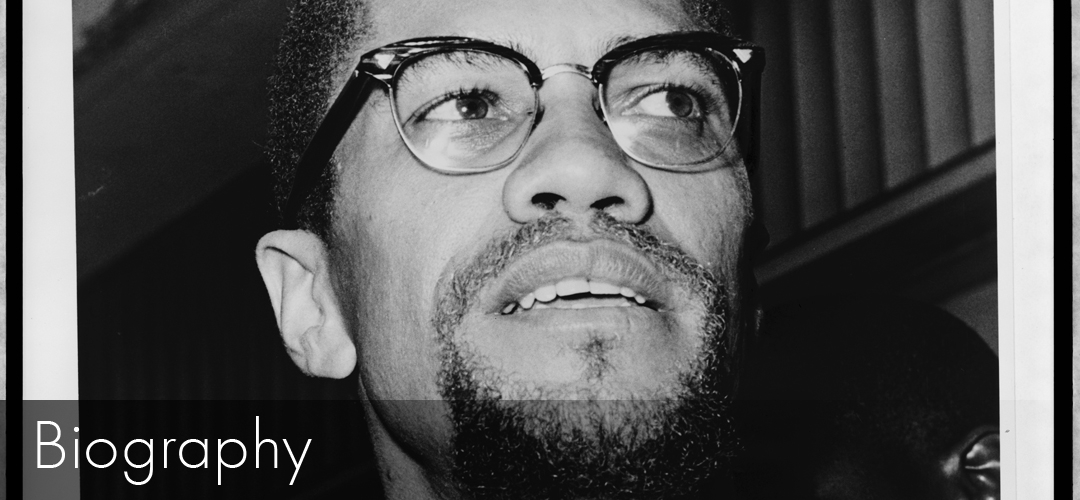 |
| Who is Malcolm X: Biography, New Evidence in Assassination and Personal Profile |
What is New Evidence in Malcolm X Assassination
Fifty-six years after the death of Malcolm X, lawyers said they revealed what they called new evidence of a conspiracy, perpetrated by the NYPD and the FBI to assassinate the civil rights activist in Harlem.
The family of Ray Wood, a Black man who worked as an undercover police officer in the 1960s, and their attorney now claim Wood wrote a letter on his deathbed confessing the NYPD and the FBI conspired to kill the man born Malcolm Little.
"We clearly intend to have the Manhattan district attorney and any other authority, whether that be the United States Congress, be able to evaluate this letter and use it as crucial evidence in exonerating these black people who have been wrongly convicted by their government," said Ben Crump, a civil rights attorney.
Following the news conference, the Manhattan district attorney's office released a statement saying its review of the convictions in the Malcolm X case is "active and ongoing", NBC report.
Malcolm X was gunned down in February 1965 in Harlem during a speaking engagement. Wood's family said in his letter, Wood stated his responsibility was to ensure Malcolm X's security detail was arrested days before the assassination.
Who is Malcolm X - Biography - Family
Wife and Children of Malcolm X
Malcolm X married Betty Shabazz in 1958. The couple had six daughters.
Malcolm X was an African American civil rights leader prominent in the Nation of Islam. Until his 1965 assassination, he vigorously supported Black nationalism.
Malcolm X was a major figure in the American civil rights movement during the 1960s. Advocating for Black rights and against racist institutions in the U.S., he gained notoriety for his impassioned speeches, in particular inciting active resistance against police violence.
Estranged from the Nation of Islam by 1964, Malcolm X was assassinated in New York City on Feb. 21, 1965. His speeches and writings remain widely studied and celebrated by supporters of the civil rights movement.
After repeated attempts on his life, Malcolm rarely traveled anywhere without bodyguards. On February 14, 1965 the home where Malcolm, Betty and their four daughters lived in East Elmhurst, New York was firebombed. Luckily, the family escaped physical injury.
One week later, however, Malcolm’s enemies were successful in their ruthless attempt. At a speaking engagement in the Manhattan’s Audubon Ballroom on February 21, 1965 three gunmen rushed Malcolm onstage. They shot him 15 times at close range. The 39-year-old was pronounced dead on arrival at New York’s Columbia Presbyterian Hospital.
Fifteen hundred people attended Malcolm’s funeral in Harlem on February 27, 1965 at the Faith Temple Church of God in Christ (now Child’s Memorial Temple Church of God in Christ). After the ceremony, friends took the shovels away from the waiting gravediggers and buried Malcolm themselves.
Later that year, Betty gave birth to their twin daughters.
Short Biography Malcolm XMalcolm X was a minister, human rights activist and prominent Black nationalist leader who served as a spokesman for the Nation of Islam during the 1950s and 1960s. Due largely to his efforts, the Nation of Islam grew from a mere 400 members at the time he was released from prison in 1952 to 40,000 members by 1960. A naturally gifted orator, Malcolm X exhorted Black people to cast off the shackles of racism "by any means necessary," including violence. The fiery civil rights leader broke with the Nation of Islam shortly before his assassination in 1965 at the Audubon Ballroom in Manhattan, where he had been preparing to deliver a speech. |
Early life and Parent of Malcolm X
Malcolm X was the fourth child of Earl and Louise Little.
Malcolm X was born Malcolm Little on May 19, 1925 in Omaha, Nebraska. His mother was the National recording secretary for the Marcus Garvey Movement which commanded millions of followers in the 1920s and 30s.
His father was a Baptist minister and chapter president of The Universal Negro Improvement Association who appealed to President Hoover that Marcus Garvey was wrongfully arrested. Earl’s civil rights activism prompted death threats from the white supremacist organization Black Legion, forcing the family to relocate twice before Malcolm’s fourth birthday.
Earl Little was a preacher and local leader of the Universal Negro Improvement Association (UNIA), while his wife Louise was from the Caribbean island of Granada and a passionate Black rights activist. The city of Omaha had a history of violence between Black and white citizens.
As a prominent figure in the Black community, Malcolm X's father regularly clashed with members of the Klan, who according to Les and Tamara Payne's book "The Dead Are Arising: The Life of Malcolm X" (Penguin, 2020) threatened and intimidated the Little family, driving them out of town. In 1926 the family moved to Lansing, Michigan, but found their new life far from peaceful. Earl Little clashed with the Black Legion, a KKK splinter group known for violence towards the Black community. In 1929 the Little family home was burned to the ground, reportedly by members of the Black Legion.
Little favoured Malcolm X for his lighter complexion, and Malcolm X later recalled attending UNIA meetings and listening to his father's political speeches. On Sep. 8, 1931, Earl was run over and killed by a streetcar in the city.
The official police report stated it was an accident, but as Joseph explains: "The family immediately suspected racist violence by the Black Legion… Malcolm believed so too." Traumatized by her husband's death, and left to raise eight children alone, Louise Little's mental health deteriorated and she was committed to Kalamazoo State Hospital in 1938.
Afterwards, Malcolm X was "shuttled between foster care and juvenile facilities". Despite excellent grades, he dropped out of high school at 15 and drifted into a life of petty crime, becoming involved in drug dealing, racketeering, theft and more. Eventually the thefts caught up to him and in 1944 Malcolm X was arrested for larceny.
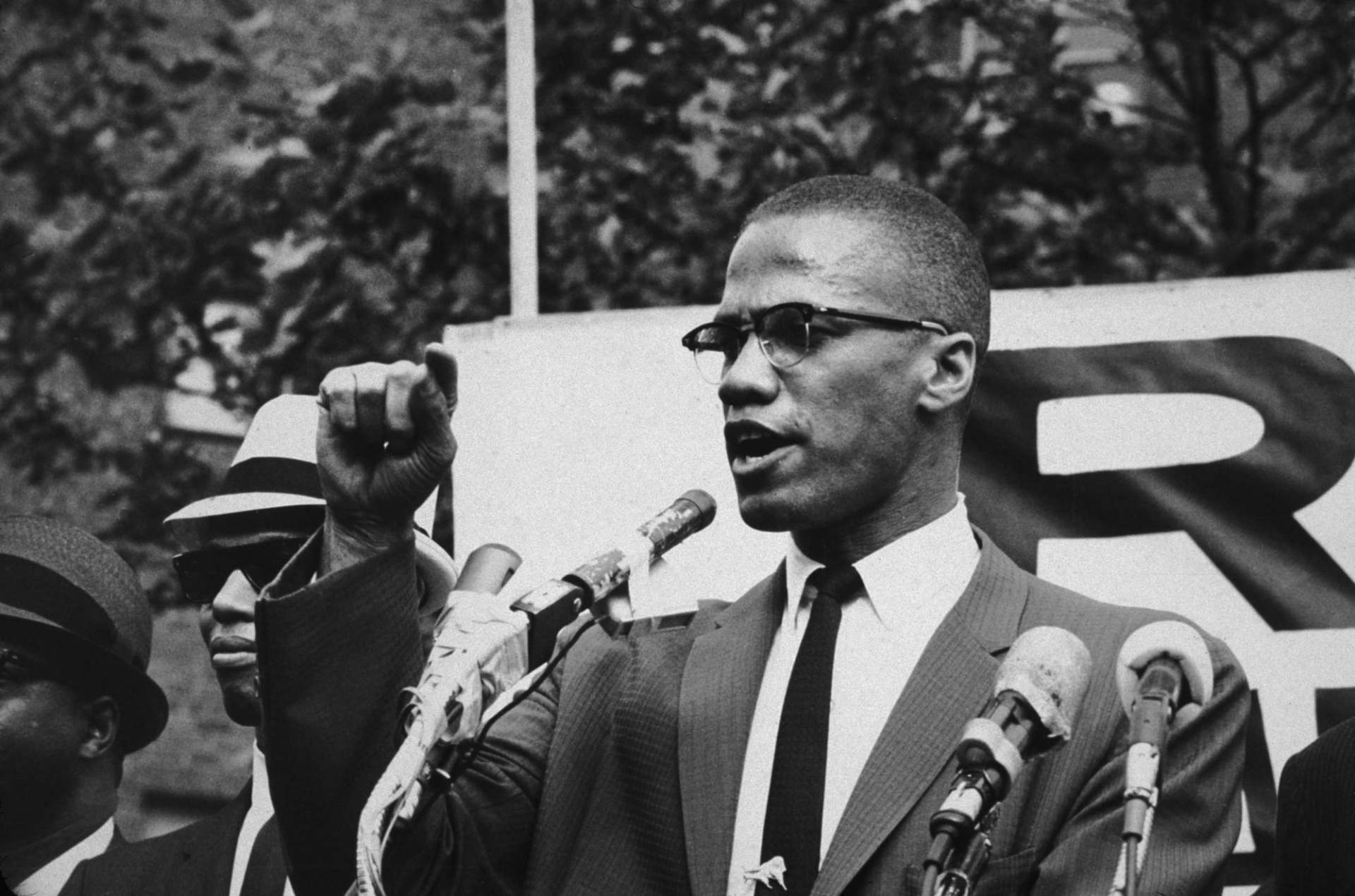 |
Career of Malcolm X - Imprisonment and the Nation Of Islam
Education Malcolm X
In 1938, Malcolm was kicked out of school and sent to a juvenile detention home in Mason, Michigan. The white couple who ran the home treated him well, but he wrote in his autobiography that he was treated more like a "pink poodle" or a "pet canary" than a human being.
He attended Mason High School where he was one of only a few Black students. He excelled academically and was well-liked by his classmates, who elected him class president.
A turning point in Malcolm Little's childhood came in 1939 when his English teacher asked him what he wanted to be when he grew up and he answered that he wanted to be a lawyer. His teacher responded, "One of life's first needs is for us to be realistic ... you need to think of something you can be ... why don't you plan on carpentry?"
Having thus been told in no uncertain terms that there was no point in a Black child pursuing education, Malcolm X dropped out of school the following year, at the age of 15.
After quitting school, Malcolm X moved to Boston to live with his older half-sister, Ella, about whom he later recalled, "She was the first really proud Black woman I had ever seen in my life. She was plainly proud of her very dark skin. This was unheard of among Negroes in those days."
Ella landed Malcolm a job shining shoes at the Roseland Ballroom. However, out on his own on the streets of Boston, Malcolm X became acquainted with the city's criminal underground and soon turning to selling drugs.
He got another job as kitchen help on the Yankee Clipper train between New York and Boston and fell further into a life of drugs and crime. Sporting flamboyant pinstriped zoot suits, he frequented nightclubs and dance halls and turned more fully to crime to finance his lavish lifestyle.
Time in Jail of Malcolm X
In 1946, Malcolm X was arrested on charges of larceny and sentenced to 10 years in jail. To pass the time during his incarceration, he read constantly, devouring books from the prison library in an attempt make up for the years of education he had missed by dropping out of high school.
Also while in prison, Malcolm was visited by several siblings who had joined the Nation of Islam, a small sect of Black Muslims who embraced the ideology of Black nationalism — the idea that in order to secure freedom, justice and equality, Black Americans needed to establish their own state entirely separate from white Americans.
He changed his name to Malcolm X and converted to the Nation of Islam before his release from prison in 1952.
While serving time in prison, Malcolm X discovered the teachings of Elijah Muhammad. Muhammad was the leader of a new religious movement, the Nation Of Islam (NOI). The central tenets of the NOI was to pay homage to their African roots and build a community tempered by Black self-reliance. In 1950, the same year the FBI opened a file on Malcolm, he dropped his surname and adopted the letter ‘X.’
Upon his release from prison in 1952, Malcolm X travelled to Chicago to meet with Muhammad. Impressed with his intelligence and tenacity, Muhammad swiftly promoted him to assistant minister. By 1957 he had risen to become the organization's national representative and the following year he married Betty X (also known as Betty Shabazz). The couple would have six children together.
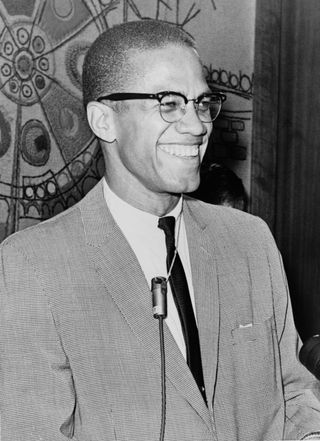 (Image credit: Public Domain, Library of Congress. New York World-Telegram & Sun Collection)
(Image credit: Public Domain, Library of Congress. New York World-Telegram & Sun Collection) A Remarkable Story of Survival and Faith Before and After Malcolm" (Ebsco Publishing, 2003), the FBI had been surveilling Malcolm as a possible communist since 1953, but shifted their focus after his rapid ascent within the NOI. The NOI had become known for its radical ideology, its ministers preaching that Black people were the first people of the world and superior in every way to white people. While civil rights organizations fought to destroy segregation, the NOI actively sought it.
The NOI and Malcolm X also gained public attention following the Johnson X Hinton incident in Harlem, April 1957. According to Rickford, when police officers violently assaulted Hinton, a Black Muslim, Malcolm X led a huge crowd to the police station, demanding Hinton receive medical attention. When the demands were met, upon a word from Malcolm X the crowd peacefully left.
That control over an angry crowd was a sign of Malcolm X’s growing power and increased media profile, which he used to openly denounce other civil rights movements for their message of protest through nonviolence. In his autobiography, he stated: “I am for violence if nonviolence means we continue postponing a solution to the American black man’s problem just to avoid violence.” Malcolm X’s ethos, “by any means necessary”, made him an imposing and inflammatory figure to some in white society and those in the Black community who disagreed with him.
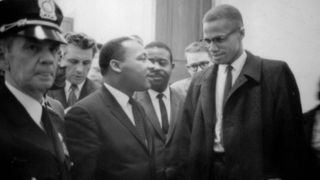 Martin Luther King Jr. and Malcolm X wait for a press conference on March 26, 1964. Photo was taken by Marion S. Trikoskor. (Image credit: Universal History Archive/Getty Images)
Martin Luther King Jr. and Malcolm X wait for a press conference on March 26, 1964. Photo was taken by Marion S. Trikoskor. (Image credit: Universal History Archive/Getty Images)
Malcolm X and Martin Luther King Jr.By the early 1960s, Malcolm X had emerged as a leading voice of a radicalized wing of the civil rights movement, presenting a dramatic alternative to Martin Luther King Jr.'s vision of a racially-integrated society achieved by peaceful means. Dr. King was highly critical of what he viewed as Malcolm X's destructive demagoguery. "I feel that Malcolm has done himself and our people a great disservice," King once said. |
In December 1963, he described the assassination of President John F. Kennedy as a sign of white America’s “chickens coming home to roost”, prompting a public outcry and leading the NOI to suspend him. In March 1964, Malcolm X announced he was leaving the movement.
A month later he gave his infamous "The Ballot or the Bullet" speech at a baptist church in Detroit, Michigan, stressing the need for African-Americans to pursue Black Nationalism and arguing against non-violent protest. "Any time you're living in the 20th century, 1964, and you walking around here singing "We Shall Overcome," the government has failed you," he said. "Today it's time to stop singing and start swinging… Cassius Clay can sing. But singing didn't help him to become the heavyweight champion of the world. Swinging helped him."
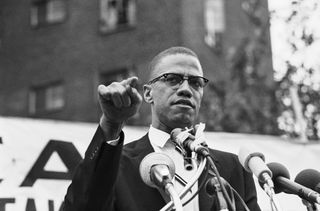 (Image credit: Bettman/Getty Images)
(Image credit: Bettman/Getty Images) Assassination and Malcolm X Day
In April 1964, Malcolm X left the U.S. for a tour of Africa and a pilgrimage to Mecca, giving speeches decrying America's treatment of Black citizens. According to Rickman, while on this trip Malcolm X embraced the peaceful doctrines of Sunni Islam and preached the importance of all Americans, regardless of race, religion or background, working together to achieve equality. He also adopted a new name, El-Hajj Malik El-Shabazz, reflecting his changed approach to his religion, and his distance from Elijah Muhammed.
Upon returning to the U.S. he had become a sworn enemy of the NOI and his family lived a life under constant threat from the NOI, as well as surveillance by the F.B.I and C.I.A. According to Rickford, Malcolm X's wife Betty was convinced he would be killed and even received an anonymous phone call claiming her husband was “as good as dead.”
On the night of Feb. 14, 1965, Malcolm X's home was fire-bombed. He and his family barely escaped the flames. Just under a week later on Feb. 21 1965, he addressed the Organization of Afro-American Unity at the Audubon Ballroom in New York. According to the book "Malcolm X The FBI File" (Skyhorse Publishing, 2012) someone in the 400-strong crowd shouted, “Get your hands out of my pocket!” Malcolm X's bodyguards waded into the crowd to quell the disturbance, but three men opened fire on him with a sawed-off shotgun and automatic pistols. Malcolm X was struck 21 times. Soon after, he was pronounced dead at Columbia Presbyterian Hospital.
Malcolm X is buried at the Ferncliff Cemetery in Hartsdale, New York.
Despite his premature death, Malcolm X's speeches and writings remain widely read. While some of his polarizing views remain debated, his contribution to the civil rights movement is broadly acknowledged and in many states May 21, his birthday, is observed as Malcolm X Day.
New evidence in Malcolm X assassination points to possible conspiracyThe family said the letter further states this move would guarantee Malcolm X not having door security at the Audubon Ballroom where he was killed. The letter was put in the hands of Ray Wood's cousin, Reggie, to be released after his death. "He was a good man that was tricked and forced to betray his own people. And he felt guilt and remorse for it, for 56 years," said Reggie Wood, also the author of "The Ray Wood Story." Today, Malcolm X's three daughters, along with Wood's family and high-profile civil rights attorney Ben Crump, are asking for the murder investigation to be re-opened in light of the new evidence. "So, what we're trying to do is talk about restorative justice is as lawyers -- try to pursue relentless justice," said Attorney Ray Hamlin. "On behalf of the legacy of Malcolm X, Dr. Betty Shabazz, on behalf of his family his lineage who is here." "There has always been uncertainty about all of the facts surrounding the assassination of my and my five sisters' father. Any evidence that provides greater insight into the truth behind that terrible tragedy should be thoroughly investigated," said Ilyasah Shabazz, daughter of Malcolm X. The three Nation of Islam members were convicted in Malcolm X's murder. In 2020, the Manhattan district attorney began a review of those convictions after meeting with representatives of the Innocence Project, a nonprofit committed to exonerating individuals who it claims have been wrongly convicted. Now, with the new evidence, the DA's office said "the review of this matter is active and ongoing." The NYPD released a statement on Saturday, that reads: "Several months ago, the Manhattan District Attorney initiated a review of the investigation and prosecution that resulted in two convictions for the murder of Malcolm X. The NYPD has provided all available records relevant to that case to the District Attorney. The Department remains committed to assist with that review in any way". |
Malcolm X Facts - Infographics
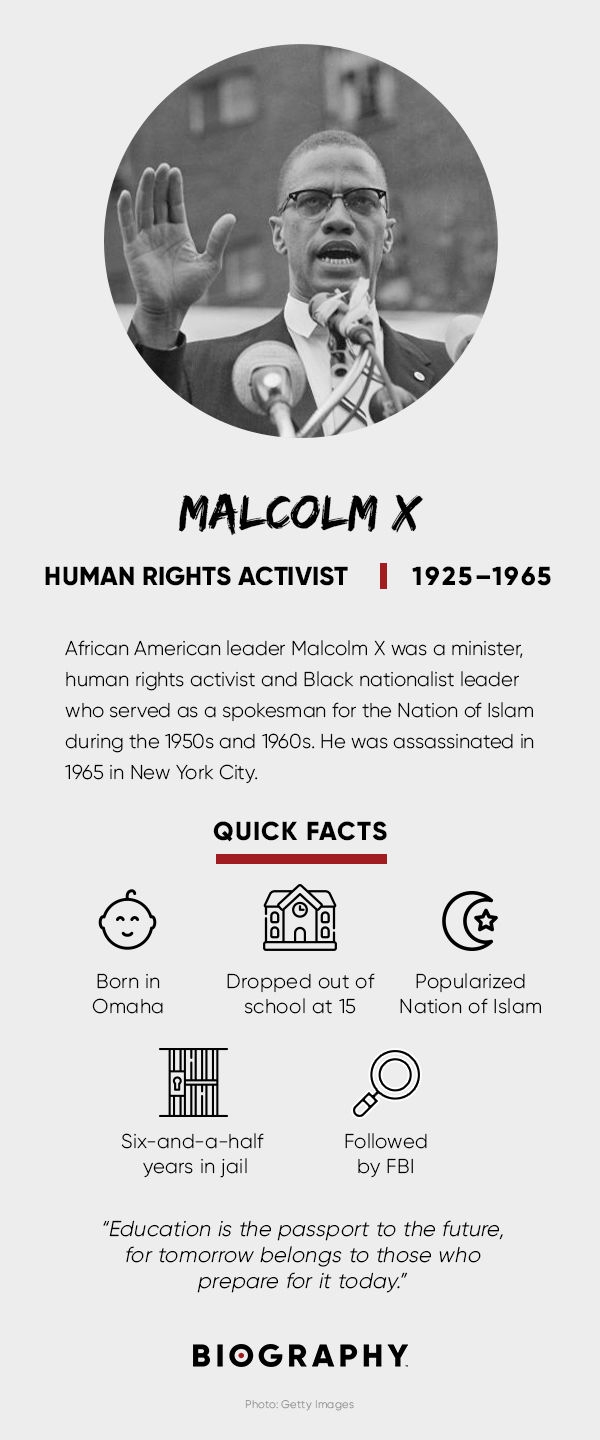 |
























